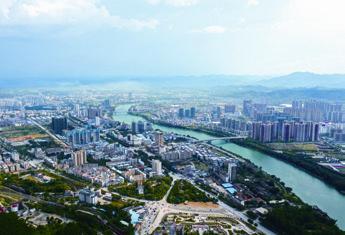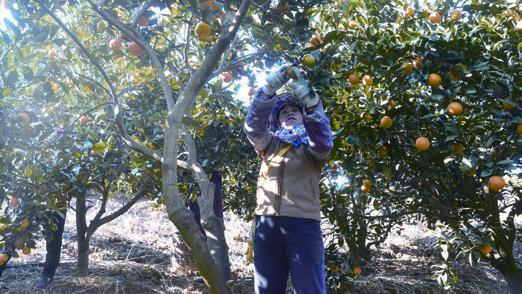Frontier Fraternity
2020-05-06ByJiJing
By Ji Jing


Located in Guangxi Zhuang Autonomous Region in south China and bordering Viet Nam, the city of Baise has a special place in Chinese history. It was here that late Chinese leader Deng Xiaoping mobilized the Zhuangs, the ethnic minority after whom the region is named, to stage an uprising against the Kuomintang authority in 1929 and built the Youjiang revolutionary base, a bastion of the Communist Party of China. The city has a martyrs monument and a museum to commemorate the uprising while the local Zhuang Opera has created a drama on the uprising.
This month, the city of over 4 million people was given a special place in national development as well, with the State Council, the cabinet, approving Baises designation as a new pilot zone for furthering Chinas opening up.
Border development
In a statement on April 7, the State Council said the pilot zone will accelerate development and opening up of border areas and strengthen cooperation with Association of South East Asian Nation (ASEAN) countries, especially Viet Nam, promoting infrastructure connectivity, industries, and a highquality and open economic system in the border regions, and propelling poverty alleviation and rural vitalization.
It will also boost the construction of the China-Indochina Peninsula Economic Corridor, the statement said. The economic corridor, an important part of the Belt and Road Initiative, originates from Guangxi and its neighboring Yunnan Province and runs through six ASEAN countries—Viet Nam, Laos, Cambodia, Thailand, Malaysia and Singapore.
“The establishment of the pilot zone will promote Baises high-level opening up, enhance cooperation with ASEAN, especially Viet Nam, and build a prosperous and stable border. It will also accelerate the transformation of growth models in Baise, consolidate the results of poverty alleviation and step up the revitalization of the revolutionary base,”Zhang Jiashou, head of the Belt and Road Research Institute of the Party School of CPC Guangxi Zhuang Autonomous Region Committee, told Science and Technology Daily.
Opening up border areas remains crucial to Chinas all-round opening up. Since 2012, eight pilot zones have been established in different border areas with that purpose, three of which are in Guangxi. These are important platforms for economic and trade cooperation with neighboring countries. Baise already has a China-Viet Nam CrossBorder Economic Cooperation Zone and has launched China-Viet Nam container trains as well as China-Europe Railway Express trains.
Ma Qingbin, a researcher with the China Center for International Economic Exchanges, told Economic Daily that new infrastructure such as high-speed railways and civil aviation facilities, new industries based on big data, and a green economy have unleashed the development potential of Chinas western and southwestern regions in recent years. “The new pilot zone will build a new growth point in southwest China…and provide a scientific way to improve border residents income and livelihood,” Ma said,“More labor forces will be absorbed in trade, processing and planting, which will help revitalize the revolutionary base, accelerate urban and rural construction in the border area and bring stability and prosperity to Baise.”
Rise from poverty
Due to its remote location, Baise had remained underdeveloped for a long time. In 2018, Zhou Yijue, Mayor of Baise, told the media that the city was one of the 14 deeply impoverished regions in the country.

The poverty alleviation drive, started in 1985, has been boosted with more Central Government support since 2016. During the period from 1985 to 2018, the number of impoverished people in the city dropped from 2.36 million to 194,600, and the incidence of poverty from an overwhelming majority of 74 percent to 5.56 percent. Over 90 percent of the impoverished locals are engaged in developing distinctive agricultural industries such as growing tangerines and breeding silkworms. The city is also the largest mango producer in China and in 2018 started a mango festival to boost tourism. Today, all villages in the city have access to hardened roads, electricity, water, TV and the Internet.

Baise also has rich aluminum, coal, manganese and copper reserves. It has developed industries based on these resources as well as a cement industry. The citys industrial output increased from 8.3 million yuan ($1.2 million) in 1950 to 109.8 billion yuan ($15.6 billion) in 2018.
Tourism is another major industry. Its an important “red tourism” region, drawing visitors with its history of the Communist movement. The Baise Uprising Memorial Park, built in 2008, is a top national tourist attraction. In addition, several villages have earned fame as longevity villages for the number of their centenarian residents. Also, the city is remarkably green with 68.5 percent forest coverage, the greenest in the province.
Its transport infrastructure has improved. By 2018, it had nine expressways, 694 km of railways and direct flights to large cities such as Beijing, Shanghai and Guangzhou. Its three ports, Longbang, Pingmeng and Yuexu, have played an important role in the opening up. They helped foreign trade jump from 3.55 million yuan ($503,925) in 1993 to 21.8 billion yuan ($3.1 billion) in 2018.
Model of growth
Leyes transformation is a microcosm of the development of Baise. The girdle of mountains that gives the county its picturesque look also cut it off from the neighboring areas, making transportation difficult and slow. The farmers had no vehicles and had to carry the crops, fruits and herbs they grew to the city markets. Agricultural products could not be sold in time, making it hard for Leye to rise out of poverty.
To address the problem, the authorities began to build roads. Over 1,100 km of roads have been built and the Leye-Baise Expressway opened to traffic on January 8. Every village is now connected by road and has tap water, toilets and mobile phone towers.
The improved transportation has led to the blossoming of distinctive agriculture. The county is growing kiwifruit, tea and mango to boost the economy. Yang Shunli, a local farmer, said he was given the right to run a kiwifruit orchard over 600 square meters by the government and trained how to grow the fruit. He is expect- ing to see his income rise.
The development of these industries has fostered tourism. Another villager, Zou Ming, said he has opened a restaurant. “In the past I had little income and found it diffi cult to make ends meet, especially as I have two school-age children. Now I have a stable income from the restaurant,” he said.
Leyes beautiful natural environment is a major attraction for tourists. The local government encourages investment in tourism infrastructure and villagers are supported to start hostels and restaurants, and organize cultural performances and rural life experience programs. Tourism has become a stable and sustainable source of income.
Now with Baise designated as a development pilot zone, the villagers expect more benefi ts to percolate to them. Last year, Zhou said at a press conference that Baise will promote the further development of distinctive industries, build cross-border industrial cooperation parks and international scientifi c and technological cooperation bases. It will also promote cross-border tourism and labor cooperation.
